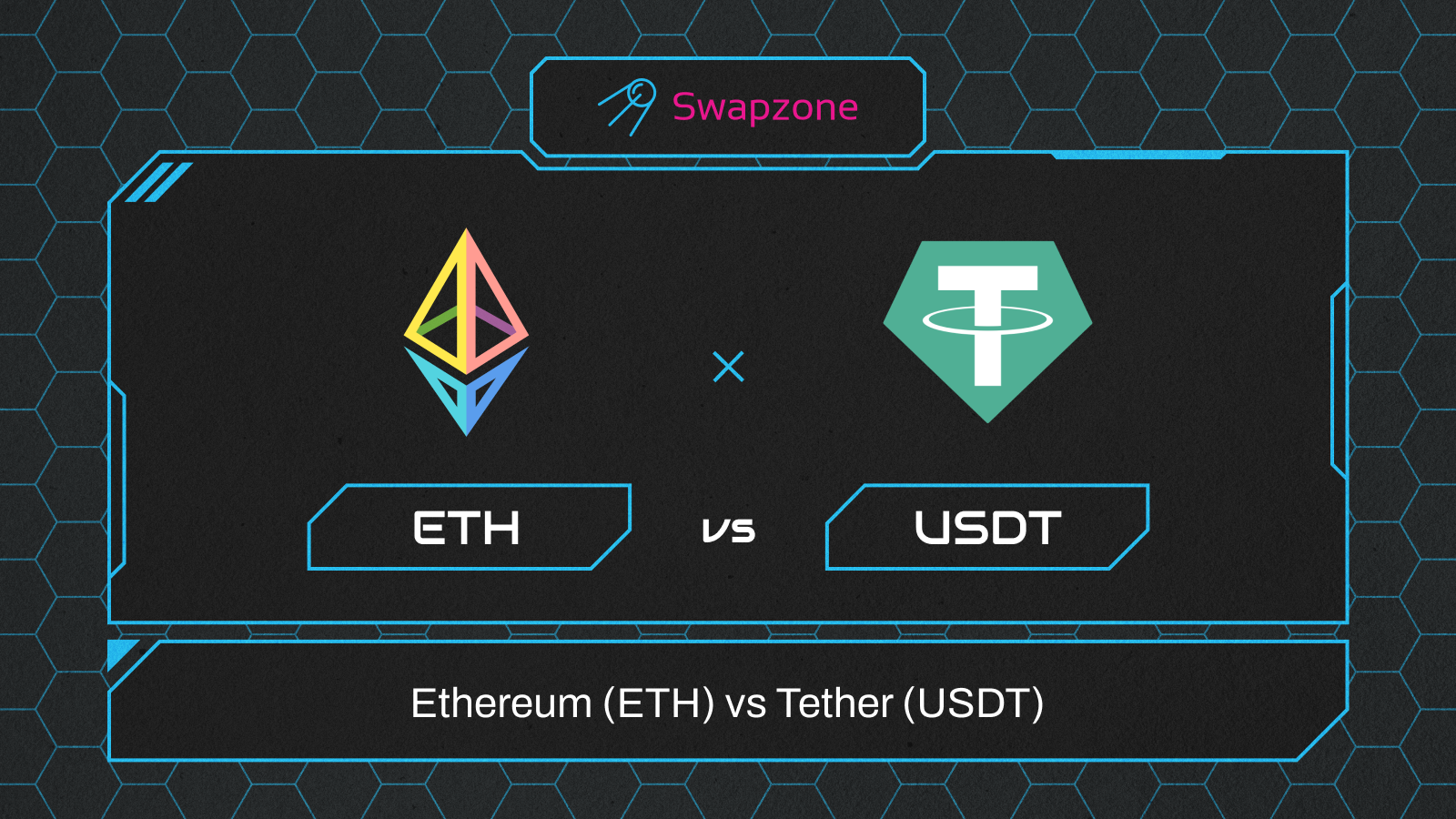In the world of cryptocurrencies, Ethereum and Tether (USDT) emerge as prominent yet distinctly different assets, each with its unique role and impact on the market. Ethereum leads in DApps, smart contracts, and decentralization. Tether offers stability, pegged to fiat, serving as a key crypto medium. In this article, we’ll explore significant differences between Ethereum, a DApp powerhouse, and USDT, a pioneering stablecoin.
Introduction to Ethereum and Tether: Understanding Cryptocurrencies for Investment and Functionality
Ethereum and Tether stand out as cryptocurrencies with distinct roles and functionalities. Ethereum is the leading platform for decentralized applications (dApps). It holds the position as the second-largest cryptocurrency by market capitalization.
Ethereum’s blockchain technology facilitates the creation and execution of smart contracts, enabling developers to build a wide array of decentralized applications ranging from decentralized finance (DeFi) to non-fungible tokens (NFTs).
Tether is a stablecoin, that has carved its niche as a pioneering digital asset as fiat money in crypto. It is designed to maintain a stable value by pegging it to fiat currencies like the US dollar. Tether’s stability attracts traders and investors seeking refuge from cryptocurrency volatility, backed by fiat reserves for confidence in value stability.
Ethereum and Tether differ significantly in purpose and functionality: Ethereum enables decentralized applications, while Tether serves as a stable medium of exchange.
Understanding these distinctions is crucial for investing and portfolio diversification. In the subsequent analysis, we’ll explore the key differences between both, including their features, use cases, and implications for the broader cryptocurrency landscape, offering valuable insights for investors.

The Uniqueness of Ethereum: A Platform for Decentralized Innovation
Ethereum stands out as a groundbreaking open-source platform at the forefront of digital innovation. Its architecture supports decentralized applications (dApps) and smart contracts, revolutionizing the way transactions are conducted and digital assets are managed.
Ethereum uses blockchain technology and cryptographic methods to ensure transparency and security. They enable self-executing agreements. And that is an incentive for automating processes and eliminating the need for intermediaries.
At the heart of the ecosystem is its native cryptocurrency, Ether, or ETH coin. It serves as both a digital currency and a token for facilitating transactions and incentivizing network participants. Additionally, its compatibility with ERC-20 cryptocurrencies has spurred the proliferation of diverse digital assets, including stablecoins and non-fungible tokens, or NFTs.
Moreover, the foundation functions as crypto-fuel, powering the smart contracts execution and transactions within the network. This positions Ether as a valuable asset, essential for interacting with the platform’s functionalities. Also, the transition to Ethereum 2.0 and the implementation of proof-of-stake consensus, provides scalability, security, and sustainability.
In essence, Ethereum’s open-source infrastructure, and innovative features position it as a cornerstone of the digital economy, driving unprecedented levels of efficiency, transparency, and inclusivity.
The Role of Tether in the Cryptocurrency Ecosystem: Stability and Transparency
Tether, or USDT, is a pioneering cryptocurrency among stablecoins. It provides stability in the volatile crypto market. USDT’s value is pegged to the fiat currency USD. Each USDT token is backed by a corresponding amount of traditional currency held in reserves by Tether Limited.
Tether first operated on the Omni Layer protocol atop the Bitcoin blockchain. Ever since, Tether has expanded its presence across multiple blockchain platforms, including Ethereum and Tron, broadening accessibility and usability. In terms of consensus mechanisms, Tether employs several mechanisms:
- Proof-of-Solvency: It provides transparency and bolsters trust among investors. Additionally, periodic audits by independent firms serve to verify the adequacy of Tether’s reserves, further enhancing its credibility.
- Proof-of-Stake (PoS): Originally utilizing Proof-of-Work (PoW) on the Bitcoin blockchain, Tether has transitioned to PoS on other platforms for enhanced efficiency and security.
- Proof-of-Reserves: Aims to provide real-time transparency on Tether’s dollar reserves, reassuring users of stability and integrity.
Overall, Tether is a stablecoin backed by fiat currency reserves, coupled with its adoption of robust consensus mechanisms and transparency measures. Tether positions it as a cornerstone of stability within the dynamic crypto market.

Key Differences and Comparative Insights: Ethereum vs Tether
Both cryptocurrencies represent contrasting pillars within the cryptocurrency landscape, each with unique functionalities and utilities.
Ethereum blockchain, renowned for its versatility, enables developers to create a wide array of decentralized solutions, fostering innovation across various industries. However, its transaction speed can be slower compared to some alternatives.
- Advantages of Ethereum:
- Supports a broad range of decentralized solutions;
- Fosters innovation across various industries;
- Disadvantages of Ethereum:
- Transaction speed can be slower compared to some alternatives.
In contrast, Tether is a stablecoin, pegged to fiat currencies like the US dollar. Its stability makes Tether a preferred choice for transactions within the crypto space, offering a reliable medium of exchange. However, Tether’s utility is primarily limited to facilitating transactions, lacking the expansive capabilities of Ethereum’s dApp ecosystem.
- Advantages of Tether:
- Provides stability and transactional efficiency
- Reliable medium of exchange within the crypto space
- Disadvantages of Tether:
- Utility primarily limited to facilitating transactions
- Reliance on fiat reserves could raise concerns about centralization
In essence, the choice between two hinges on individual preferences and needs and priorities.
| Ethereum | Tether | |
| Total Supply of Coins | 120,093,479 ETH | 107.79B USDT |
| Current Available Supply | 120,093,479 ETH | 104.01B USDT |
| Market Capitalization | $414.3B | $104.07B |
| Average Transaction Cost | $2.3 | $0.64 |
| Primary Use | Smart Contracts, dApps | Fiat currencies usage on blockchains |
| Founder | Vitalik Buterin | Brock Pierce |
Conclusion: Navigating Choices in Cryptocurrency Investments
Ethereum and Tether stand as prominent entities in the cryptocurrency market, each offering distinct characteristics suited to varying investment strategies and operational requirements.
Ethereum offers decentralized innovation through dApps and smart contracts, attracting investors seeking transparency and long-term growth. Its versatility and in settlement transparency make it appealing to investors seeking exposure to decentralized technologies and potential long-term growth.
Tether’s stability as a stablecoin appeals to risk-averse investors in the volatile crypto market. Understanding the contrast between Ethereum and Tether is key for informed cryptocurrency investment decisions, balancing stability with Tether against Ethereum’s innovation potential.
The choice is mostly between stability with Tether or the innovative potential of Ethereum’s decentralized platform. Investors must weigh their options carefully, considering both the opportunities and risks associated with their chosen investment path.
FAQs
Both cryptocurrencies serve different purposes. Tether is a stablecoin pegged to the US dollar, providing stability, while Ethereum is a blockchain platform enabling smart contracts and decentralized applications.
They are not the same. Ethereum is a blockchain platform for decentralized applications and smart contracts, while USDT is a stablecoin pegged to the US dollar.
People buy USDT for various reasons. It can be trading, hedging against cryptocurrency market volatility, transferring funds quickly between exchanges, and seeking a stable store of value within the crypto ecosystem.


